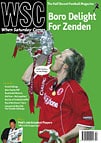 Religion and football remain a potent and unpleasant mix. Robbie Meredith examines the problems on both sides of the border in Ireland
Religion and football remain a potent and unpleasant mix. Robbie Meredith examines the problems on both sides of the border in Ireland
In 1998, in a routine attempt at male bonding, I took my son to his first international at Windsor Park to see Northern Ireland play Moldova. Our players wore green, but numerous fans sported Rangers scarves of red, white and blue or the purple and orange colours of the Orange Order. Many bellowed “No Surrender!” in the midst of the national anthem, while The Sash, the Protestant marching song, was sung regularly.
Although I did not hear any explicit sectarian abuse on that occasion, it came as no surprise when, in a match against Norway in early 2001, sections of the home crowd booed Neil Lennon whenever he received the ball. The Northern Ireland team have always been mixed, but Lennon had committed the heinous crime, in some eyes, of joining Celtic and the treatment he received echoed that given to a lesser known local Celtic player, Anton Rogan, at Windsor Park in the early Nineties.
The Irish Football Association's community relations programme, partially aimed at making Windsor Park a more inclusive and welcoming venue, seemed to be in tatters, yet the Lennon incident acted as a catalyst for the IFA, making them adopt a more comprehensive approach to challenging sectarianism. Michael Boyd, the Association’s community relations officer, admits that the events were “very depressing”, but argues that they were symptomatic of a wider breakdown of trust between the IFA and supporters. “There was a poor relationship between the fans and the IFA. The only way to eradicate sectarian chanting was to work with the supporters in a partnership approach, rather than merely introduce codes of conduct.”
As a result, an advisory panel was established which contained representatives from a range of organisations, including supporters’ clubs. Subsequently, the Football For All project was born, promoting good relations in local football through on-the-ground initiatives such as community relations and equality training for local coaches, increased cross-community work linking a range of youth and community groups with supporters’ clubs, and more visible messages against bigotry at home games.
While the initiative could not prevent Lennon’s horrendous departure from international football following a Loyalist death threat in 2002, the atmosphere at Windsor Park has improved significantly. More green is worn, while The Sash has been replaced by less divisive chanting, such as “Stand Up for the Ulstermen”, and, especially recently, “All we are saying is give us a goal”.
However, problems still loom. The – relatively meagre – funding for Football For All is due to end in 2005 and Windsor Park, situated beside Belfast’s predominantly Loyalist “Village” area, remains a forbidding venue for many in the community. Additionally, many Northern nationalists prefer to support the Republic of Ireland and would rather travel to Lansdowne Road in Dublin than make the short journey to Windsor.
Yet Dublin is not immune to sectarianism either. Shota Arveladze of Rangers was abused by a section of the crowd when playing there for Georgia in 2003, echoing the reception given to other Rangers players in previous matches. His treatment so incensed Ken McCue, a spectator and a founder of the Sport Against Racism In Ireland organisation, that he complained to UEFA, who warned the Football Association of Ireland about the conduct of the home support.
The chief executive of the FAI, Fran Rooney, condemned the booing of Arveladze, which he described as “racist but also bigoted and sectarian”, but McCue questions the FAI’s commitment to tackling the problem on an ongoing basis. “They panicked. They contracted a PR company but in terms of action they’ve done nothing. Sport Against Racism In Ireland, for instance, get no support from the FAI.”
In some quarters, McCue was accused of being unpatriotic for highlighting the Republic’s problem and a website was set up by some supporters defending their right to boo Rangers players at Lansdowne Road. McCue, whose father was an Ireland international, is dismissive of their arguments. “There is no excuse for sectarian or racist abuse. There are a couple of Dublin kids at Rangers. One of them won’t even tell his mates. What happens if they are selected by Ireland? Will we boo them?” Others, however, point to wider social factors behind the situation. Damian Smyth, who writes on Scottish football for the Belfast Telegraph, sympathises with McCue but argues that, in Ireland, the Old Firm provide a relatively benign channel for the expression of identity. “Far better to have an allegiance to a football club on social, religious or political grounds than to beat up or stab someone,” he states. “Rangers and Celtic represent conceptions of national identity much more than is the case for other football clubs.”
Booing a player because of the team he plays for is relatively unremarkable, but barracking him because he plays for Rangers or Celtic is more insidious, as the player is, at least in part, being abused for their perceived religious or ethnic affiliation, highlighting the similarities between sectarianism and racism. Indeed, racism in Ireland is the coming storm. A recent increase in immigration, on both sides of the border, has exposed the worst aspects of Irish insularity, as racist attacks in Belfast and Dublin have increased, while sections of the national media have indulged in Daily Mail-style rants against immigrant communities.
Both football associations in Ireland have made piecemeal efforts in response, but more will be needed. Football in Ireland cannot float free of society’s problems, but perhaps it is time for the conceptions of nationhood which inspire football allegiances here to be questioned much more critically.
From WSC 206 April 2004. What was happening this month